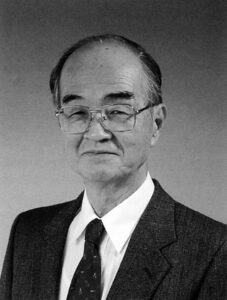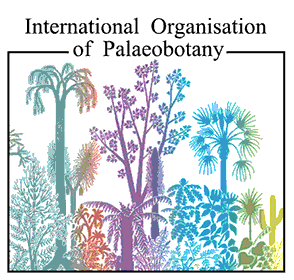
Dr. Toshimasa Tanai was a leading figure in the field of Cenozoic paleobotany in Japan, and the path he followed is a history of the developmental period of Cenozoic paleobotany. He was born in Aichi Prefecture, Central Japan on August 19, 1923, and entered the Department of Geology, Faculty of Science, Tokyo Imperial University after graduating from Daiichi High School. During his bachelor degree, he specialized in Cenozoic stratigraphy under Professor Yanosuke Otsuka, and was engaged in surveys of coal fields and oil fields in the Tohoku and Hokkaido regions for the development of fuel resources, especially during the difficult period immediately after the end of the World War II. At that time, Professor Otsuka had many talented researchers in various fields such as Cenozoic stratigraphy, tectonics, neotectonics, and natural geography, as well as paleontology. Dr. Tanai played an important role among these students. In 1951, Dr. Tanai was appointed to the Geological Survey of Japan (GSJ), where he continued his research and studies focusing on coal geology. In his investigation of the Nishitagawa coalfield in Yamagata Prefecture of Northeast Japan, he conducted pioneering research on volcanic stratigraphy from the viewpoint of stratigraphy of igneous activity; it was quite natural that he became interested in abundant plant fossils along with coal seams. He started his paleobotanical research as a near-self-taught researcher, and was occasionally trained by a botanist, Professor Fumio Maekawa of the University of Tokyo.
In 1956, he joined the Department of Geology and Mineralogy, Faculty of Science, Hokkaido University as an Assistant Professor, and was in charge of the Fuel Geology Course with Professor Yasuo Sasa and Assistant Professor Seiji Sato. He was promoted to Professor in 1972, and was engaged in teaching and research of fuel geology and paleobotany for more than 30 years until his retirement in March 1987, and trained many excellent geologists and geological engineers. After retiring from Hokkaido University, he became a visiting researcher at the National Museum of Nature and Science for two years from 1989. During those two unforgettable years, he gave me a broad perspective on the future of paleobotany (paleontology) and the role of Natural History Museums. He also made great efforts in the research of Paleogene plants in the Eocene Ishikari Group in Hokkaido and in the maintenance of the archives.
Professor Tanais paleobotanical research accelerated after he was appointed to Hokkaido University. In 1961, he published his doctoral dissertation entitled “The Neogene floral change of Japan” in the Bulletin of Hokkaido University. This large monograph systematizes the biostratigraphic position of the terrestrial strata by examining the chronology of the marine strata, and clarifies the evolution of the Neogene flora by dividing it into six floristic types. Around the time of his dissertation work, there was a major turning point in Japanese paleobotanical research.
At the time when Dr. Tanai was working on Cenozoic plants in earnest, Professor Shigeru Miki, who proposed the genus Metasequoia, and Professor R. W. Chaney, a paleobotanist at the University of California, who was the first to send a research team to the natural habitat of Metasequoia in China, were well known worldwide. In 1958, Professor Chaney approached Professor Miki about research project on the “Tertiary flora of Japan” with financial support from NSF, and this project continued for a long period of time from the following year until Professor Chaney’s sudden death in 1971. Professor Tanai was the youngest member of the Japanese side. The research funds provided at that time were far greater than the scientific research funds in Japan, but the success of this project was sometimes threatened due to differences in the way of thinking about research funds and research reports. Dr. Tanai worked hard to overcome these difficulties, and in 1963,”Tertiary Flora of Japan——Miocene Flora” was published to commemorate the 80th anniversary of the Geological Survey of Japan, and in 1972,”Tertiary Flora of Japan, Vol. 2″ was published. These two volumes of English-language papers are the milestones that introduced the study of the Tertiary flora of Japan to the world, and were highly acclaimed.
Dr. Tanai’s research has been consistent in his desire to clarify the evolution of the Tertiary flora of Japan from a paleobotanical viewpoint, and also to clarify the flora and vegetation of the present-day temperate forests of East Asia including Japan. The so-called boreal origin theory (Arcto-Tertiary Geoflora) is well known for the establishment of temperate forests in the boreal hemisphere, but many inconsistencies were pointed out both in the fossil record and in theory. In order to verify this theory, Dr. Tanai explained that it is necessary to conduct a detailed taxonomic study and phylogenetic relationship for each taxon, and then to clarify the phytogeographic evolution of each phylogenetic group. For a detailed taxonomic study, he used a method of examining fossil leaves based on the comparative morphology of fine venation characters and he has made abundant cleared-leaf slides of modern leaves. Although it was difficult to establish phylogenetic relationships, he pointed out the importance of including as many traits as possible, including fossil and living species, even before the establishment of phylogenetic analysis methods. A series of studies on fossil and living maple species are representative of his work. In the same vein, he also published a number of studies on the genera Nothofagus and Fagus.
Now that trait evolution and phylogeography are being actively discussed on the basis of molecular phylogeny based on genetic information, the importance of high-quality fossil records is being reaffirmed. Dr. Tanai’s research approach has been consistent in that he describes and presents the fossils on which he bases his investigations, and he also registers and stores specimens to contribute to future research. Organizing and storing specimens as collections is a necessary and basic part of paleontology and natural history science, but it is not as easy as it sounds to do so perfectly. Dr. Tanai, being meticulous by nature, did it himself, together with Toshiko Watanabe of the Fuel Geology Department.
Professor Tanai served on the editorial board of Review of Palaeobotany and Palynology, for 29 years from 1968, just after the journal’s first issue appeared. As an editorial board member or reviewer, one of his specialties was to get to the essence of the matter and to make comments, sometimes politely, sometimes harshly. Similarly, many researchers in Japan and abroad have been greatly encouraged by his careful comments in letters when they sent reprints of his papers. He also served as the Japanese representative of the International Organization of Paleobotany (1979-1986). He was invited to give lectures at the 11th (Seattle, 1969), 13th (Adelaide, 1981), 14th (Berlin, 1987) and many international meetings including the International Conference of the Birbal Sahni Institute of Palaeobotany in India.
Education to the students at Hokkaido University was strict. His strict guidance, both public and private, sometimes lasted late into the night. This was his uncompromising attitude toward research, and it was done with educational considerations in mind. His strictness was the flip side of his consideration for his students, and many alumni recall how grateful they were for this.
Although he was not a strong drinker, he liked to discuss and debate over a cup of sake. Since he also liked to smoke, it was not uncommon for the discussion to go deep into a smoke screen. There are countless times when, at his invitation (or provocation), I presented my own arguments, only to have them successively debunked. He was born in the year of the boar, and he once happily told me that he was a “pig in the rush of life. I, too, was born in the year of the boar, two rounds apart from him, and although I was a young man, I was not going to let that stop me from responding. I am grateful for the thought-provoking discussions and guidance I received from him, which I would not have been able to replace in any way.
He and Professor Jack A. Wolfe (U.S. Geological Survey, later University of Arizona) were longtime friends and co-authors of several monographs on the Miocene flora of the Kenai Peninsula in Alaska and on the fossils of the genus Acer in North America. Professor Wolfe died unexpectedly last August when he fell from a cliff while collecting fossils in the mountains of California. When I reported the sad news to Dr. Tanai, he was very disappointed. This was at the time when an international symposium was being planned to celebrate the 70th birthday of Professors Wolfe and D. L. Dilcher (University of Florida). Both professors, who share the same date of birth, are leading American paleobotanists of the Cenozoic Era. This symposium was held at the University of Florida in March of that year. Dr. Tanai had been in poor health since February before the symposium, but he seemed to be concerned about the symposium until the last minute. I attended the Florida meeting (Advances in Paleobotany, recognizing the contributions of David L. Dilcher and Jack A. Wolfe on the occassion of their 70th year) with Professor Harufumi Nishida (Chuo University), and it was with great regret that we had to report the passing of Dr. Tanai. Since the friendship between Professor Tanai and Professor Wolfe was well known to researchers in other countries, we received many kind words of regret for his passing.
In 1979, Dr. Tanai received the Scientific Award of the Palaeontological Society of Japan (Academic Encouragement) for his research on Cenozoic paleobotany. He also served as a councilor (1973-1996) and president (1985-1962) of the society, and devoted himself to the management of the society and the development of paleontology. He has also served the Geological Society of Japan, the Society of Resource Geology of Japan, and the Japanese Association of Historical Botany, and devoted himself to the development of geology and paleontology. In addition, he was an expert member of the Science Council of the Ministry of Education, a liaison member of the Science Council of Japan for Paleontology, an expert member of the Coal Mining Council, an expert member of the Mining Council, a member of the Petroleum Council, a member of the Yubari New Coal Accident Investigation Committee, and a member of Hokkaido, New Energy Development Organization, Hokkaido Development Agency, etc. He contributed greatly to the development of academia and the promotion of the coal mining and petroleum mining industries. In 2000, he was awarded the Order of the Rising Sun, Gold Rays with Neck Ribbon for these achievements.
Finally, the fossil plant specimens, cleared-leaf slides, herbarium sheets, and fruit and seed specimens of the reference modern plant specimens that he was involved in, together with the collection of his papers on paleobotany, are all organized and stored together in the Paleobotany Collection of the National Museum of Nature and Science. We believe that it is the best parting gift to his will that these materials, which he intended and took time to organize, will be utilized in the future.
Dr. Kazuhiko Uemura
Excerpted and translated from the Journal of the Palaeontological Society of Japan (PSJ), vol. 80, pp. 70-74, 2006
